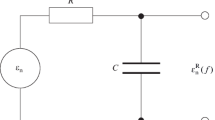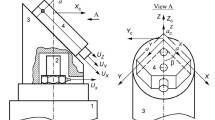Abstract
The development of the low-frequency-vibration apparatus described in this report was done in response to a need to establish and verify vibration-pickup performance at infrasonic frequencies. The exciter design is an extension of the Dimoff type exciters1 and, in fact, many of its components are identical.
The motion of such an exciter must have very low distortion and minimal components of motion in all directions other than axial. In addition, the attainable amplitude must be large enough to produce a transducer signal that can be accurately measured. The attainable amplitude and accuracy of transducer calibration on this exciter is limited by transducer size, weight, geometry and vibration sensitivity. Examples of the types of accelerometers which can be calibrated on this exciter are servo or force balance, piezoelectric, piezoresistive and strain gage.
Similar content being viewed by others
Abbreviations
- A :
-
acceleration amplitude (m/s2)
- a :
-
instantaneous acceleration (m/s2)
- D :
-
displacement amplitude (m)
- d :
-
instantaneous displacement (m)
- f :
-
frequency (Hz)
- L :
-
length (m)
- n :
-
line pairs/m (m−1)
- P :
-
percent distortion
- S :
-
transducer sensitivity (V·s2/m)
- η:
-
pulses per cycle
- θ:
-
angle (rad)
- λ:
-
wavelength of light (m)
- ξ:
-
percent error
- τ:
-
period (s)
- ϕ:
-
angle (rad)
References
Dimoff, T., “Electrodynamic Vibration Standard with Ceramic Moving Element,”J. of the Acoust. Soc. of America,40 (3),671–676 (Sept.1966).
Bulletin D05000-7-66, “Model D05000 Digital Vibration Calibration Sensor,” Unholtz-Dickie Corporation, Hamden, CT.
Logue, S. H., “A Laser Interferometer and Its Application to Length, Displacement, and Angle Measurement,” Inst. of Enviro. Sci. 14th Ann. Tech. Meeting (1968 Proceedings).
American National Standards Institute, S2.2-1959, “Methods for the Calibration of Shock and Vibration Pickups” (Nov. 27, 1959).
Harris, C. M. andCrede, C. E., Shock and Vibration Handbook,1,Ch. 18,McGraw-Hill Book Co.,New York (1961).
Author information
Authors and Affiliations
Rights and permissions
About this article
Cite this article
Koyanagi, R.S. Development of a low-frequency-vibration calibration system. Experimental Mechanics 15, 443–448 (1975). https://doi.org/10.1007/BF02410344
Issue Date:
DOI: https://doi.org/10.1007/BF02410344




